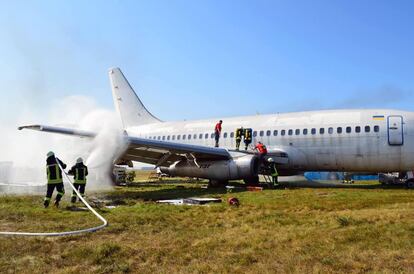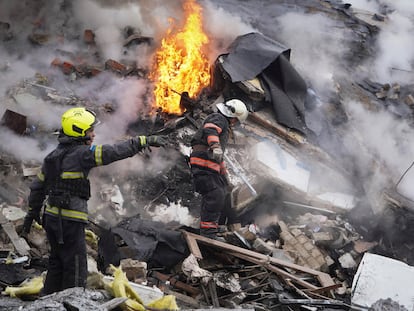Ukraine dreams of reopening its airspace to civil aviation
President Zelenskiy’s team has launched a plan to resume passenger flights at Kyiv’s international airport, despite the ongoing war


Volodymyr Zelenskiy wants passenger planes to fly in and out of Ukraine again. Few believe that the president’s plan is possible during the war, but it’s also true that his country has achieved — during the almost two-year-long Russian invasion — other feats that once seemed impossible. For instance, few considered it feasible to circumvent the blockade imposed by the Russian fleet in the Black Sea but, since last autumn, merchant traffic in Ukrainian ports has increased. For the president’s office, the current priority is to reconnect Ukraine with the outside world by air.
On December 1, 2023, Andriy Yermak — Zelenskiy’s right-hand man — affirmed that Boryspil International Airport, in Kyiv, would “soon” receive commercial flights again. Yermak stated this in a meeting with ambassadors from allied countries that was held at the main Boryspil terminal. Each diplomat was given a boarding pass as a souvenir. “I trust that this symbolic boarding pass will be valid soon,” Yermak said, adding: “We can guarantee the security of the [airfield] thanks to our Armed Forces and your countries.” On December 19, Zelenskiy also took a position on the matter: “The opening of Boryspil will be a victory for Ukrainian air defense: it will show that Ukraine is winning.”

Unlike other Ukrainian airports, the one mentioned hasn’t been damaged. A spokesperson for the facility explains to EL PAÍS that they’re ready to handle flights, but that she cannot comment on details of the plans announced by the president’s office. The aerodrome maintains its activity as a training center for ground personnel. In July 2023, Boryspil received a visit from the president of Ryanair, Michael O’Leary. The businessman promised to establish 75 routes between Ukraine and the rest of Europe “when the airspace is safe.”
Ukraine closed its airspace in February 2022, when the Russian invasion began. Officially, only four planes have left the country since then: two Turkish military planes that were in Ukraine when the war broke out, a plane from the Hungarian airline Wizz Air — which was also besieged and took off for Poland in September 2022 from Lviv, in the west of the country — and the last, a Boeing 777 from Skyline Express, a Ukrainian firm, which departed this past December. The journey of this last aircraft — between Kyiv and Tarbes (in the south of France), without passengers — was taken as evidence that recovering the air connection is possible. The plane — according to Ukrainian media — flew to the border with Romania with its transponder disconnected, the device that allows the radars in the control towers to locate the device at all times. It cruised at an altitude of 12,000 feet. Upon leaving Ukrainian airspace, the Boeing activated the transponder and climbed higher.
Despite the success of the Skyline Express flight, its operation to leave Ukraine is hardly valid as a reference for future commercial flights. Deactivating the transponder is a maneuver that the International Civil Aviation Organization (ICAO) strictly rules out in its manual for civil flights in or near conflict zones. The military must always be able to identify the location of the plane, according to the ICAO manual. This document — updated in 2023 — is one of the sector’s regulatory bibles for operating in areas with armed activity. “No airline can make a flight to an airport where the ICAO hasn’t certified its operations,” explains Miguel Palacios, a retired Spanish pilot with decades of experience in national and international flights.
ICAO is an organization made up of 193 states, coordinating civil aviation operations. Palacios recalls that ICAO protocols are required by the International Air Transport Association (IATA) — which brings airlines together — and by the Federal Aviation Administration (FAA), the U.S. body that regulates the sector. The air safety guidelines in Ukraine largely rely on IATA and the FAA approval, meaning that the reopening of Boryspil International Airport is also dependent on this. Rostyslav Shurma — deputy-director of Zelenskiy’s office — admitted this on January 18 at the World Economic Forum in Davos.
Shurma noted that only 20% of the decisions required to open airspace depend on Kyiv. The rest of the steps are the responsibility of the IATA, the FAA, international partners, independent regulators and insurers. Zelenskiy’s representative stressed that the Ukrainians are working “intensely” with their allies to make this possible. He specifically mentioned the cooperation they’ve established with the Israeli authorities.
Zelenskiy has reiterated that Israel is his role model for protecting Ukraine’s airspace. Ben Gurion Airport receives flights from international airlines on a daily basis, despite the presence of missiles fired by groups such as Hezbollah and Hamas, or by their own anti-aircraft batteries. Kirilo Novikov — an air security expert — explained to Ukrainian media on January 24 that Israel has decades of experience in this field, especially thanks to its U.S.-provided Iron Dome anti-aircraft system. Novikov stated that the only option for Ukraine would be to establish an air corridor to the border with a level of anti-aircraft protection similar to that of the Israeli state. On the other hand, Oleg Zhdanov — a reserve colonel — told Ukrainian media that he saw this strategy as unrealistic.
At Davos, Shurma indicated that the priority is to reopen Boryspil, but he doesn’t rule out having to opt for the airport in Lviv, less than 40 miles from the Polish border. Boryspil has better anti-aircraft defenses and is close to more people, but Russian missiles and drones are constantly hitting Kyiv. In any case, all airports — being strategic infrastructure — are under threat of military action, as highlighted by the Conflict Zone Alerting System — a platform of the EU Aviation Safety Agency that monitors the danger in territories where armed activity occurs.
“Who would want to get on a plane that could be shot down by a Russian missile?” Zhadnov asked, “or by one of our own missiles, if there’s a massive attack [and our] defenses have to act?” The ICAO manual focuses on “the most significant risk to civil aviation: surface-to-air missiles,” which include air defense systems.
It was precisely the downing of a passenger plane in Ukraine that caused a global change in civil aviation safety protocols. Malaysia Airlines flight MH-17 had taken off on July 17, 2014, from Amsterdam, bound for Kuala Lumpur. As it flew over the Donetsk province, a surface-to-air missile fired by pro-Russian separatists shot it down, killing nearly 300 people.
Since that tragedy, new systems were created, such as the EU warning map, the ICAO manuals, or Canada’s Safer Skies initiative, an aviation safety monitoring program. At the 2023 Safer Skies annual meeting last July, Volodymyr Hromov — deputy director of Ukrainian State Aviation Administration — detailed the draconian measures formally required to reopen Ukrainian airspace: official reports and statements indicating the end of hostilities, the end of martial law and the cancellation of airspace restrictions. However, Hromov added a caveat, which is what Zelenskiy’s team could be working on: that national and international organizations — in addition to two independent analysis centers — demonstrate that there’s been a reduction in the level of risk. Hromov indicated that this would also require an observation period of between four to six months to confirm that the threat has decreased.
Ukrainian society is in need of hope, at a time when the war is controlled by Russia and the conflict has no signs of ending. In October 2023, on a visit to the city of Uzhhorod — located in the west of the country, adjacent to the border with Slovakia — an EL PAÍS correspondent met a couple from Kyiv. They were sightseeing in the region, pointing their phones at the sky: on the horizon, you could see a passenger plane, flying over EU territory. The couple explained that the image surprised them: they had forgotten that flying by plane is normal in any European country, except for Ukraine.
Sign up for our weekly newsletter to get more English-language news coverage from EL PAÍS USA Edition









































